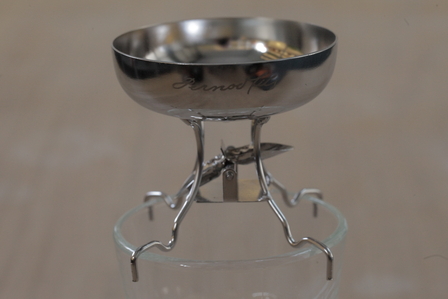How to serve absinthe
Words by Simon Difford
Absinthe adds a distinctive flavour to cocktail and long drinks and is widely called for in vintage cocktail books. However, two ritualistic styles of serve are synonymous with absinthe. Both drip water over a sugar cube which gradually dissolves, dripping sweet water into the absinthe below.
The more authentic method, the traditional French way to serve absinthe, is appropriately known as the Absinthe Drip. A contemporary Czech method is similar but involves first soaking the sugar cube in absinthe and igniting the highly flammable spirit.
Traditional French absinthe serve (Absinthe Drip)

1. Pour a shot (1oz/30ml) of absinthe into a tall, wide-rimmed glass.
2. Rest specially designed slotted absinthe spoon across the top of the glass.
3. Place a sugar cube on top of a spoon on the glass.
4. Slowly drizzle or drip ice-cold water over the sugar cube so that the water is evenly displaced into the absinthe until the drink is diluted to a ratio between 3:1 and 5:1.
5. Use spoon to stir drink and then enjoy.
French absinthe is both strong and bitter, therefore is traditionally diluted and sweetened before drinking. Originally a waiter would serve a measure of absinthe, a carafe of iced-water and sugar separately leaving the drinker to prepare their drink according to their own preferences. As the drink gained popularity, the absinthe fountain came into being.

Absinthe fountain
Absinthe fountains usually consist of a large glass jar of iced-water mounted on a pedestal with a number spigots, each with a tap, allowing a number of drinks to be prepared at once without the need to hold a carafe over each drink.

Absinthe brouilleur (or brouille)
Pronounced 'brew-yah', a brouilleur is a device that sits atop each absinthe glass, straddling the rim, acting like a mechanised personal fountain. Iced water is added to the bowl, slowly dripping through a hole in the base of the bowl, often dropping onto a seesaw arm mechanism and then into the absinthe below. Sugar syrup can be added to the water in the bowl, or in some cases, a sugar cube can be placed on a built-in grille between the bowl and the glass.

Absinthe glasses
Special glasses were also developed for serving absinthe with a dose line, bulge, or bubble roughly a quarter of the way up to indicate how much absinthe should be poured. Typically these indicate a measure, or 'dose', of 1oz/30ml of absinthe but some called for as much as 1½ oz/45ml.

Contemporary Czech sugar and burn serve
This Czech method of serving absinth (without the 'e') involves a ritual not dissimilar to that used in the preparation of narcotics. It appears likely that this was adapted from the traditional Café Brûlot, a traditional coffee drink that calls for igniting a sugar cube soaked with brandy.
This serving method should only be practised with Czech absinth and should not even be discussed if a French absinthe enthusiast is present. It's not that they are killjoys but that the caramelising of the sugar impairs the true flavour of absinthe.
WARNING: Before the litigation lawyers start rubbing their hands with glee, please beware of the bleeding obvious: due to its high alcoholic strength absinth is extremely flammable so extreme caution and appropriate safety measures should be observed when performing this ritualistic serve. Please do not move or attempt to carry glasses while the absinth is still alight. Be aware that the fine blue flame may be difficult to see so may be alight without your realising. Lastly if you are a bloody idiot then please don't blame us.
1. Pour a shot (1oz/30ml) of absinthe into a tall, wide-rimmed glass.
2. Put a lump of sugar on a spoon and dip it in the absinthe until it is saturated.
3. Hold the spoon over the glass and set the sugar alight. This will cause it to bubble and caramelise.
4. When the flame has died down, stir the sugar into the absinthe.
5. Finally add at least twice as much iced-water and some ice if required and stir again.
Speed of dilution
Some say the slow drip-by-drip dilution of absinthe is essential to its flavour and that fast hydration, which quickly forces the spirit's components that are not soluble in water (mainly fennel and star anise) out of solution, causing the drink to turn milky (known as louche) is detrimental to flavour.
In my experience there is little or no difernable difference in flavour between slowly and quickly diluted absinthe, as long as the proportion of sugar and water are identical. The slow drip is more about ritual and theatre than flavour. Thus to consistently attain the same flavour consider dilution with a measured amount of chilled water and sugar syrup. Who wants to faff around with an absinthe fountain when fixing a drink to enjoy while watching the TV?









